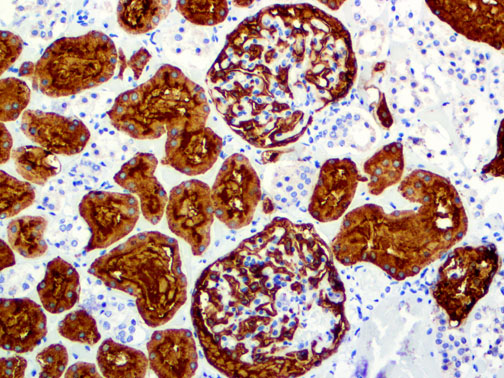
IHC of CD10 on an FFPE Kidney Tissue
| Intended Use | For In Vitro Diagnostic Use | |||||||||||||||||||||||||||||||||||
| Summary and Explanation | CD10, also known as neutral endopeptidase (NEP), Neprilysin, and common Acute Lymphoblastic Leukemia antigen (CALLA), is a zinc-dependent metalloprotease enzyme that degrades a number of small secreted peptides, most notably the amyloid beta peptide whose abnormal misfolding and aggregation in neural tissue has been implicated as a cause of Alzheimer’s Disease. CD10 is a useful marker for the characterization of childhood Leukemia and B-cell Lymphomas. This antibody reacts with the antigens of Lymphoblastic, Burkitt’s, and Follicular Lymphomas, and Chronic Myelocytic Leukemia. Also, CD10 detects the antigen of glomerular epithelial cells and the brush border of the proximal tubules. This characteristic may be helpful in interpreting renal ontogenesis, in conjunction with other markers. Other non-lymphoid cells that are reactive with CD10 are breast myoepithelial cells, bile canaliculi, neutrophils, a small population of bone marrow cells, fetal small intestine epithelium, and normal fibroblasts. | |||||||||||||||||||||||||||||||||||
| Antibody Type | Mouse Monoclonal | Clone | 56C6 | |||||||||||||||||||||||||||||||||
| Isotype | IgG1 | Reactivity | Paraffin, Frozen | |||||||||||||||||||||||||||||||||
| Localization | Cytoplasmic, Membranous | Control | Kidney, Tonsil, Lymph Node | |||||||||||||||||||||||||||||||||
| Presentation | CD10 is a mouse monoclonal antibody derived from cell culture supernatant that is concentrated, dialyzed, filter sterilized and diluted in buffer pH 7.5, containing BSA and sodium azide as a preservative. | |||||||||||||||||||||||||||||||||||
| Availability |
| |||||||||||||||||||||||||||||||||||
| Note: For concentrated antibodies, please centrifuge prior to use to ensure recovery of all product. | ||||||||||||||||||||||||||||||||||||




